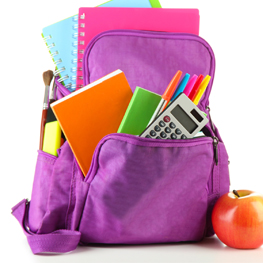
You’ve just finished buying new school clothes and loaded up on all the supplies. Now it’s time to buy a backpack. When shopping for a backpack, function takes precedence over fashion. Comfort, support and size are very important factors that need to be considered when picking the right backpack. Just like kids in class, backpacks come in all different shapes and sizes. Avoid buying the biggest and cheapest backpack thinking you are getting a bargain. This purchasing strategy could actually be harmful to your child’s back.
By the end of the teen years, more than 50 per cent of youth experience at least one low back pain episode. Hauling heavy backpacks on an ongoing basis can cause stress to a growing spinal column. Researchers have found that one-third of students reported their parents never checked their backpack. They have also found that the backpacks of students whose parents never checked their packs weighed significantly more than the packs of students whose parents kept an eye on pack contents. In addition, less than 5 per cent of parents had actually weighed their child’s packs. You need only watch a child struggle with their overloaded backpack to understand the potential health risks to their backs and spines.
Choosing a backpack
Choose a backpack that has several pockets instead of one large compartment, this will do a much better job distributing the weight of the contents. It will also keep contents from shifting and putting an uneven stress on the spine. The backpack must be proportionate to body size. Don’t buy a larger pack than needed with the thoughts of having it ‘fit’your child for years to come. The top of the pack should not extend higher than the top of the shoulder, and the bottom of the pack should not fall below the top of the hipbone.
Shoulder straps should be wide, adjustable and padded. Poorly designed straps can dig into shoulder muscles and strain nerves. If your child complains of back pain, numbness or weakness in their arms and legs, get help to prevent future problems. A hip strap or waist belt will distribute as much as 50 to 70 per cent of the weight off the shoulders. Forget leather, buy a pack that is made with a much lighter material, such as vinyl or canvas.
Packing your pack
Weight is the biggest issue here. They’re not moving out, so make sure that your child’s backpack is less than 15 per cent of their body weight. The younger the child, the lower the percentage should be. For elementary school children, stick to 10 per cent. Anything higher will be putting undue strain on a body that not only can’t deal with it, but could potentially be harmful to it. Pack heavy items closer to the body, and ensure that the weight distribution is equal from left to right. Pack any odd-shaped items on the outside of the pack so that they don’t dig into the back.
Some examples of average weights of items you may put in a pack:
Textbook: 2 to 6 lbs.
Wet towel: 2 lbs.
Laptop: 6 lbs.
Shoes: 2 lbs.
Lunch: 2 lbs.
Water bottle: 1.25 lbs.
A heavy backpack will distort the natural curve in the middle and lower back, which leads to muscle strain along with irritation in the spine, joint and muscles. It will also cause rounding of the shoulders and put stress on neck muscles, contributing to headaches and neck pain.
Lifting the pack
As with all lifting, avoid twisting. If you are not there to help your child put on their pack, which is the best option, have your child lift the pack onto a waist high table before lifting it onto their back.
Carrying the pack
Wear both straps and adjust them so the pack is snug to the body. You should still be able to slide your hand between the pack and your back.
Wearing the pack on one side will cause the spine to lean towards the opposite side placing stress on the joints and muscles of the mid- and lower back. This may increase the likelihood of back problems later in life.
We are recognizing more and more the spinal health hazards of heavy backpacks as they alter posture and gait. We are also learning the link between childhood back problems and adult back problems. Effects can be cumulative over time. Chiropractors play an important role in providing preventative education, early detection as well as providing chiropractic care in the treatment of backpack related injuries.
Chad is a chiropractor. He has published numerous articles in a variety of magazines and newspapers throughout Canada. With his youngest patient being only weeks old, he is a strong believer that you are never too young to get the best health care available. For more information, visit shilohclinic.ca.
Calgary’s Child Magazine © 2024 Calgary’s Child